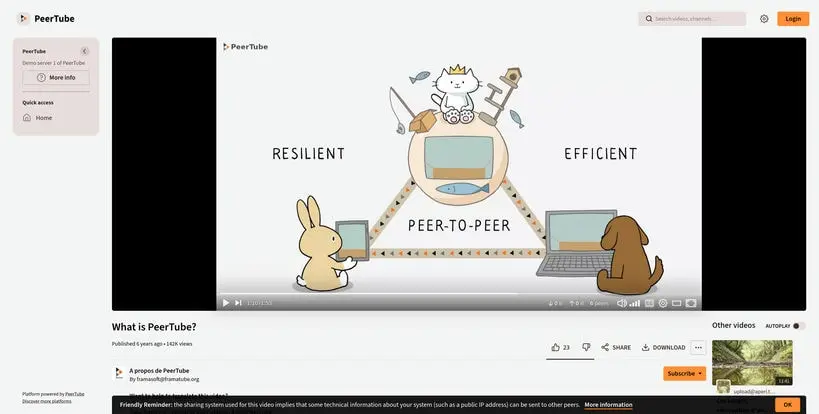PeerTube service

Source: the PeerTube repository on Github
PeerTube is a decentralized, open-source video hosting platform empowering users to share and discover content without centralized control, over the Fediverse.
Features¶
Key features of PeerTube include:
- Decentralized Video Hosting: Host videos across a decentralized network of interconnected instances, ensuring resilience against censorship and promoting a distributed web.
- Open-Source Platform: Built on open-source technology, PeerTube encourages collaboration and transparency among developers and contributors worldwide.
- Enhanced Privacy Controls: Customize privacy settings to safeguard user data and ensure a secure viewing experience.
- Community-Driven Content Discovery: Discover diverse content through community-driven recommendations, tags, categories, and curated playlists.
- Customizable Instance Creation: Create tailored instances for private communities or public platforms, with flexibility and customization options to meet specific needs.
- Federated Network: Communicate and share content seamlessly across instances while maintaining autonomy and diversity within the federated network.
- Ad-Free Experience: Enjoy an ad-free viewing experience for both creators and viewers, prioritizing content quality and user experience.
Usage¶
We host your PeerTube instance at a URL like: https://peertube.your-server.com — just replace your-server.com with your actual server domain, and open the URL on your browser. Welcome to your PeerTube instance!
Optional S3 storage¶
PeerTube supports S3-compatible providers, which allows it to store its content (audio/image/video/etc.) in an object storage system like Amazon S3 or another S3-compatible object storage providers like Backblaze B2, Storj, Wasabi, Digital Ocean Spaces, Cloudflare R2, etc.
Moving media files off of the server’s local filesystem and into an external storage (the S3 storage system) allows you to free up disk space on the server and effectively gives you infinite storage (for a relatively-cheap price).
See this page for details about how to choose the Amazon S3 compatible object storage provider which suits your needs and set it up for the service.
Power up with PeerTube
Start using PeerTube today - get a managed Matrix server with it pre-installed, or add it to your existing setup.